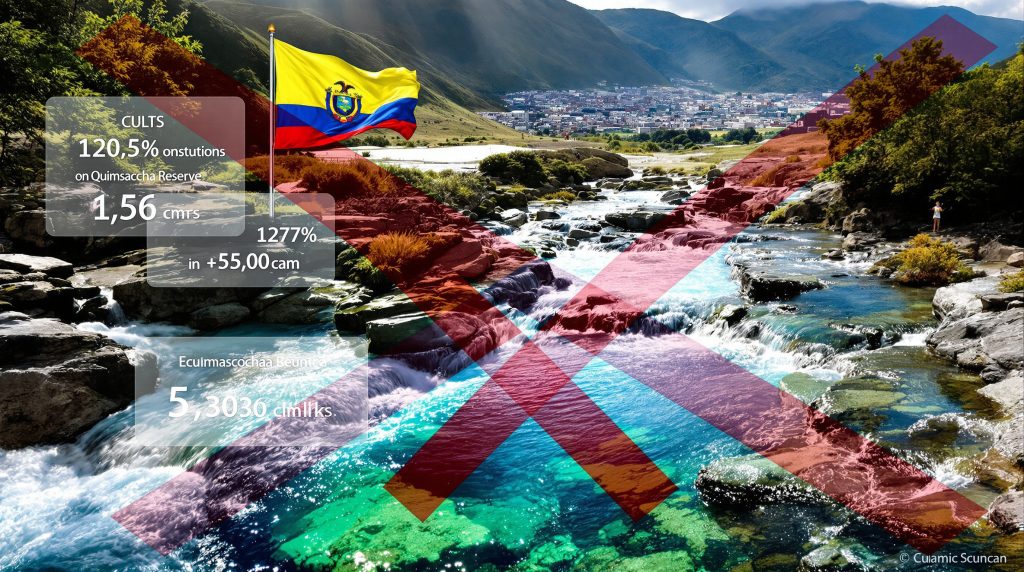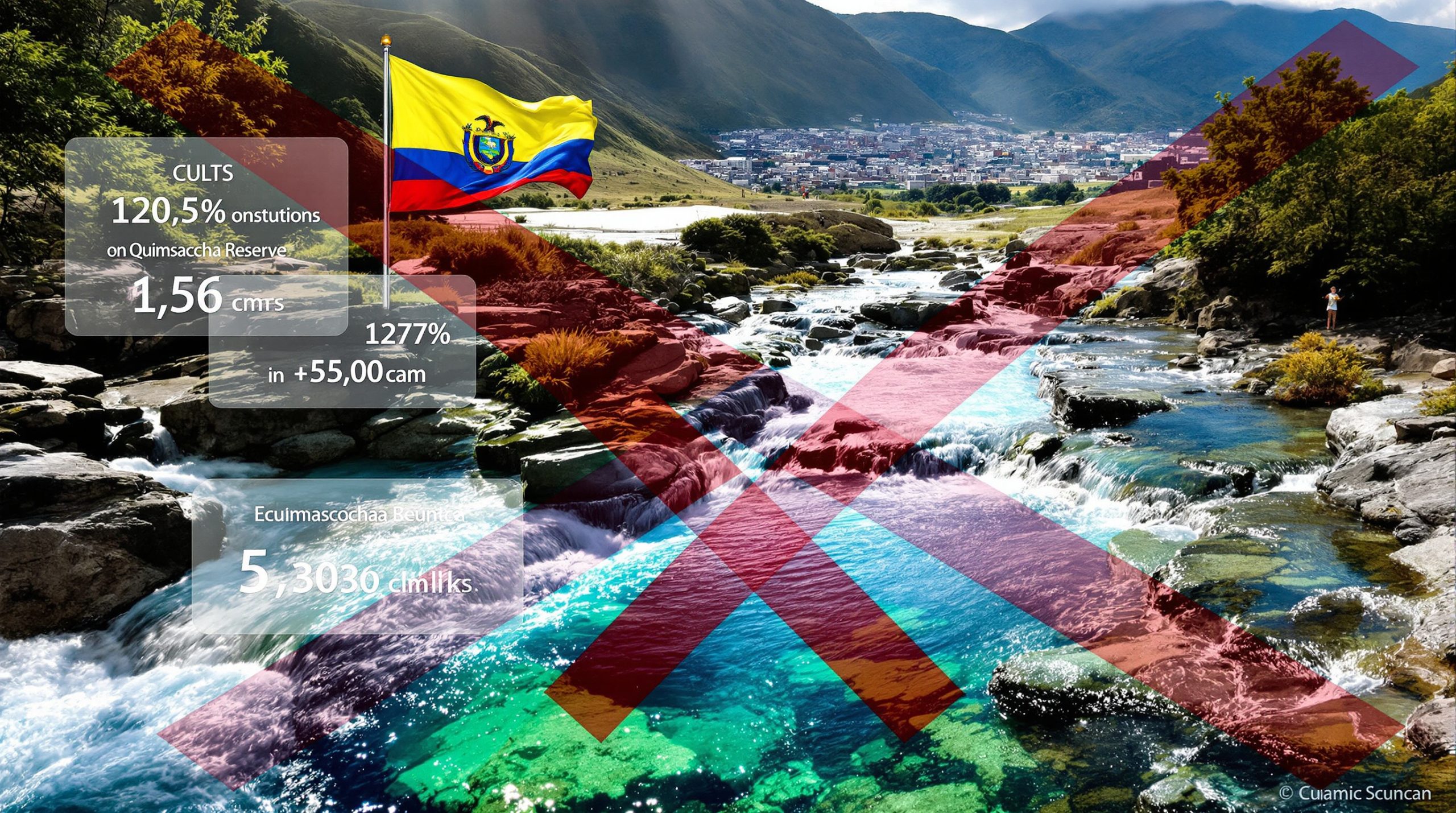Ecuador Revokes Loma Larga Gold Project's Environmental License: What Happened and Why?
Ecuador's government has officially revoked the environmental license for the Loma Larga gold project, citing ecological concerns and water protection as primary reasons. The decision comes after mounting pressure from local communities and authorities in Azuay province who have fought against the project for years due to its potential impacts on critical water resources.
The government's official reasoning
The Environment and Energy Ministry based its decision on technical reports submitted by authorities in Cuenca and Azuay responsible for managing the region's drinking water and irrigation systems. These reports highlighted significant risks to:
- The Quimsacocha water reserve
- Local community health
- Regional ecological stability
In its official statement, the ministry emphasized: "The national government reaffirms its commitment to the rights of nature, the defense of water sources, and, under the precautionary principle, the protection of the health and well-being of the people of Cuenca and Azuay."
Timeline of escalating tensions
- July 2025: Initial environmental license granted to DPM Metals
- August 2025: Government suspended project activities pending an environmental management plan
- October 2025: Complete revocation of the environmental license
What is the Loma Larga project and its economic significance?
The Loma Larga gold project represents a significant potential mining development in Ecuador's resource sector, with substantial projected economic impacts that now face uncertainty.
Project specifications and investment details
| Project Element | Details |
|---|---|
| Location | Azuay province, 30km southwest of Cuenca |
| Planned Investment | $419 million |
| Projected Annual Production | ~200,000 ounces of gold (first 5 years) |
| Additional Minerals | Copper, silver |
| Current Status | License revoked |
Economic implications of the cancellation
The revocation creates several economic ripple effects:
- Loss of potential foreign direct investment
- Reduction in projected tax revenue for Ecuador
- Elimination of anticipated job creation
- Possible deterrent effect on other junior mining investments in the country
Why are local communities opposing the Loma Larga project?
The opposition to Loma Larga stems from deep concerns about environmental protection and water security, particularly regarding the Quimsacocha water reserve.
Water security concerns
Local residents and authorities have consistently highlighted that mining operations could:
- Contaminate crucial freshwater sources
- Reduce water availability for agriculture and drinking
- Disrupt natural hydrological systems
- Create long-term environmental liabilities
The Quimsacocha ecosystem at risk
The Quimsacocha Reserve encompasses over 3,200 hectares of sensitive Andean "paramo" ecosystem, which:
- Functions as a natural water collection and filtration system
- Represents one of Ecuador's most important water sources
- Contains unique biodiversity adapted to high-altitude conditions
- Provides essential ecosystem services to surrounding communities
Community activism and political pressure
Cuenca Mayor Cristian Zamora, who has been a leading voice against the mine, celebrated the decision at a public event, stating: "It has been a decades-long struggle." This highlights how:
- Local governance structures actively opposed the project
- Community organizing created sustained political pressure
- Environmental concerns transcended multiple political administrations
- Public opinion favored water protection over mining development
How does this decision reflect Ecuador's broader mining policy?
The Loma Larga license revocation fits into a complex national context regarding resource development and environmental protection in Ecuador.
Ecuador's mining sector challenges
Despite possessing significant gold and copper deposits, Ecuador's mining sector faces substantial hurdles:
- Only two mining companies currently operate in the country
- Recent legal rulings have halted multiple projects
- Local opposition has successfully blocked developments
- Constitutional protections for nature create unique regulatory frameworks
Balancing development and environmental protection
Ecuador's approach reflects the tension between:
- Attracting foreign investment and developing natural resources
- Protecting ecologically sensitive areas and water sources
- Respecting indigenous and local community rights
- Implementing constitutional "rights of nature" provisions
Regulatory uncertainty for mining companies
For mining companies, Ecuador's decision signals:
- Heightened environmental scrutiny even after licenses are granted
- Increased weight given to local community perspectives
- Potential for project license revocation after significant investment
- Need for more comprehensive environmental and social planning
What was DPM Metals' approach to environmental management?
DPM Metals, which acquired the Loma Larga project in 2021, had presented plans for responsible development that ultimately failed to satisfy regulatory requirements and community concerns.
Environmental commitments and proposed mitigations
The company had outlined several environmental management strategies:
- Underground mining methods to minimize surface disturbance
- Water management systems designed to protect local resources
- Waste management plans to prevent contamination
- Commitments for mine reclamation innovation for post-mining restoration
Regulatory compliance challenges
Despite these commitments, DPM faced significant challenges:
- Failure to produce an acceptable environmental management plan
- Inability to address community concerns about water impacts
- Difficulties navigating Ecuador's evolving regulatory framework
- Challenges in balancing economic objectives with environmental protection
What are the implications for mining investment in Ecuador?
The revocation of DPM's environmental license raises important questions about the future of mining investment in Ecuador and similar jurisdictions.
Investor confidence considerations
This decision may impact investor sentiment in several ways:
- Increased perception of regulatory risk in Ecuador
- Higher risk premiums for mining projects in environmentally sensitive areas
- Greater emphasis on social license in investment decisions
- Potential shift toward jurisdictions with more stable mining permitting basics
Environmental standards evolution
The case highlights evolving expectations regarding:
- More rigorous environmental impact assessments
- Greater weight given to water resource protection
- Increased influence of local communities in approval processes
- Higher standards for environmental management planning
Alternative development pathways
Ecuador now faces choices about:
- Developing more selective criteria for mining approvals
- Exploring economic alternatives to resource extraction
- Strengthening environmental governance systems
- Balancing regional development needs with ecological protection
How does the Loma Larga case compare to other mining conflicts?
The Loma Larga situation reflects broader global tensions between mining development and environmental protection, particularly regarding water resources.
Similar cases globally
The Loma Larga conflict parallels other mining-water disputes:
- Conflicts over mining near glaciers in Chile and Argentina
- Water-related mining opposition in Peru's highland regions
- Indigenous resistance to mining on traditional lands in Australia
- Community opposition to mining near watersheds in North America
The water-mining nexus
Common elements in these conflicts include:
- Competition for water resources in water-stressed regions
- Concerns about long-term contamination risks
- Cultural and spiritual values attached to water sources
- Scientific uncertainty about hydrological impacts
What legal frameworks influenced this decision?
Ecuador's decision to revoke the environmental license was shaped by several distinctive legal and constitutional elements.
Ecuador's "Rights of Nature" constitutional provisions
Ecuador's 2008 Constitution uniquely:
- Recognizes nature itself as having legal rights
- Establishes the precautionary principle in environmental decisions
- Creates constitutional grounds for ecological protection
- Provides legal standing for environmental protection cases
The precautionary principle application
In this case, authorities applied the precautionary principle, which:
- Allows preventive action before scientific certainty of harm
- Places burden of proof on project proponents
- Prioritizes preventing potential environmental damage
- Enables regulatory action based on reasonable concern
Judicial precedents in Ecuadorian mining cases
Recent court decisions have:
- Expanded interpretations of environmental rights
- Strengthened local government authority in resource decisions
- Recognized indigenous consultation requirements
- Established higher standards for environmental impact assessments
What happens next for the Loma Larga area?
With the environmental license revoked, several scenarios could unfold for the Loma Larga project area and affected stakeholders.
Potential futures for the project site
Options for the Loma Larga site may include:
- Permanent protection as an ecological reserve
- Development of alternative, lower-impact economic activities
- Continued exploration of modified mining approaches
- Integration into regional water management systems
Economic alternatives for local communities
Communities near the project may pursue:
- Sustainable tourism development
- Ecological service payment programs
- Agricultural diversification and value-added production
- Artisanal and small-scale economic activities
DPM's potential responses
The company faces several possible paths:
- Legal challenges to the license revocation
- Renegotiation with modified project parameters
- Divestment from the project
- Refocus on other assets in their portfolio while avoiding investment red flags
FAQs About the Loma Larga Project Cancellation
What is the Quimsacocha water reserve and why is it important?
The Quimsacocha Reserve is a 3,200+ hectare area of Andean páramo ecosystem that functions as a critical water source in Ecuador. This high-altitude wetland ecosystem captures, filters, and gradually releases water that supplies drinking water systems and agricultural irrigation for communities throughout the region. The páramo's specialized vegetation and soil structure create natural water regulation services that would be difficult or impossible to replace if damaged.
Could DPM appeal the decision to revoke the environmental license?
Yes, DPM could potentially pursue legal challenges to the license revocation through Ecuador's administrative courts or international arbitration mechanisms, depending on investment treaties between Ecuador and Canada. However, such challenges face significant hurdles given the constitutional protection of nature and water resources in Ecuador, and the technical reports supporting the government's decision.
How might this decision affect other mining projects in Ecuador?
This decision signals heightened scrutiny for mining projects in environmentally sensitive areas, particularly those affecting water resources. Companies with existing or planned projects in Ecuador will likely need to demonstrate more robust environmental safeguards, stronger community support, and clearer water protection measures. The decision may also accelerate the trend toward more selective approval of mining projects based on their environmental footprint and community impacts.
What economic alternatives exist for Ecuador beyond mining development?
Ecuador has several potential economic development pathways beyond extractive industries, including sustainable tourism, biodiversity-based enterprises, specialty agricultural products, carbon credit programs for forest conservation, and knowledge economy sectors. The country's exceptional biodiversity, varied ecosystems, and cultural heritage provide foundations for diverse economic activities that may offer more sustainable long-term development.
What is the significance of the "decades-long struggle" mentioned by Cuenca's mayor?
The mayor's reference to a "decades-long struggle" highlights that opposition to mining in the Quimsacocha area predates the current project and company. Local communities and environmental organizations have consistently opposed various iterations of mining proposals in this sensitive watershed area, demonstrating persistent concerns about water security that transcend any specific project design or corporate owner.
Further Exploration:
Readers interested in learning more about mining projects and environmental regulations in Ecuador can explore additional perspectives on resource development challenges in Latin America, or examine how community activism has influenced mining decisions in the Andean region.
Are You Ready to Capitalise on the Next Major Mining Discovery?
Don't miss your chance to get ahead of the market on game-changing mineral discoveries like those that transformed De Grey Mining and WA1 Resources. Discovery Alert's proprietary Discovery IQ model delivers instant notifications of significant ASX mineral discoveries, turning complex data into actionable investment insights. Begin your 30-day free trial today at Discovery Alert's discoveries page to see how major mineral discoveries can generate substantial returns.




